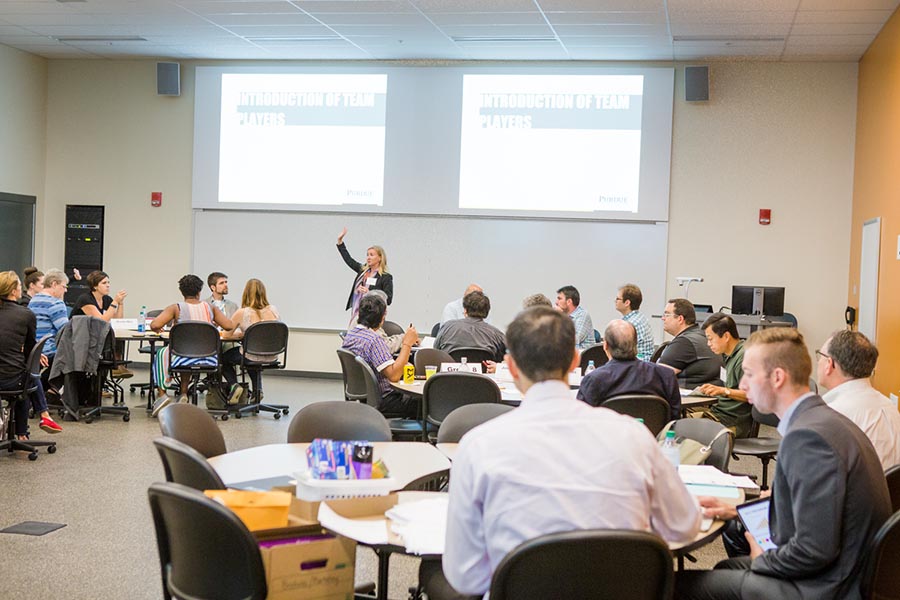Flip the script: five-year Purdue study shows flipped classrooms in Mechanical Engineering are a success

In the traditional 20th-century model of engineering education, hundreds of students sit in a large lecture hall and listen silently while a professor teaches them that week’s new material. Then the students are tested on their knowledge, based on how well they listened to the lecture. In a 21st-century flipped classroom, the theoretical material is all pre-recorded and available to the students online ahead of time, so that in-classroom time can be more focused on examples and problem solving.
“A flipped classroom enables active learning,” said Kejie Zhao, associate professor of mechanical engineering, and one of the corresponding authors of the paper. “Rather than just one-way information delivery, active learning encourages students to interact and explore the topics further.”
Active learning at Purdue has its roots in several different initiatives. In 2011, a University-wide program called Instruction Matters: Purdue Academic Course Transformation (IMPACT) helped hundreds of Purdue professors with large-enrollment classes to shift to more student-centered learning strategies. In 2013, Chuck Krousgrill and Jeff Rhoads founded Freeform, which focused these active learning strategies specifically on mechanical engineering classes. Both initiatives showed early success, reducing the number of students who withdrew from large classes, or received a D or F.
The latest study is the result of a five-year survey of a single class: ME 323 Mechanics of Materials, taught by Zhao. He taught the class traditionally in 2014 and 2015, and then using the flipped classroom method from 2015 to 2017. The study was conducted by Hyun Jin Cho, Cho Rong Lee, and Debra Runshe of Purdue’s Center for Instructional Excellence. Statistical analysis showed that students in the flipped classroom scored better on exams than the traditional students, and performed better overall in the class.
In addition, a cohort of the same class in 2019 answered open-ended surveys to provide qualitative feedback on the flipped classroom format. The results were clear: students overwhelmingly preferred the option to review video lectures beforehand, finding them helpful as both a preview to the class, and a review for exams. They also found them extremely useful in explaining the theoretical concepts of the class, and flexible in being able to review on their own time.
The research has been published in the International Journal of STEM Education.
Zhao isn’t surprised by the results. “Active learning has been such a huge benefit for our students,” he said. “I now give class quizzes, where groups of students collaborate to complete the quiz, and they love it. Sometimes they learn more from their peers then they would learn from me!”
Having the flipped classroom materials also prepared Zhao for the recent COVID lockdowns. “At first, it was technically challenging to record lectures in this way,” Zhao said. “But once you have the videos, you can use them for any semester. Videos can’t fully replace in-person classroom environments, but when the requirements came for online and hybrid learning, I was ready to adapt, and so were my students.”
“Overall, I’m glad to see this positive feedback,” he continued, “but most of all, I’m glad that students perform better and have better perception in this type of learning environment.”
Writer: Jared Pike, jaredpike@purdue.edu, 765-496-0374
Source: Kejie Zhao, kjzhao@purdue.edu, 765-496-0224
ABSTRACT
Hyun Jin Cho, Kejie Zhao, Cho Rong Lee, Debra Runshe, and Chuck Krousgrill
To address some challenges that the large lecture-focused courses have faced in higher education, the flipped classroom model was implemented in mechanical engineering. The purpose of the study was to investigate mechanical engineering undergraduate students’ performance in the flipped classroom. A comprehensive analysis was conducted to investigate the pedagogical benefits of active learning in the flipped classroom from a self-determination theory perspective. To evaluate the effectiveness of the flipped classroom, students’ academic achievements in the flipped classroom were compared with the ones in the traditional lecture format. Moreover, to explore in-depth students’ learning experiences and their perceptions about the flipped classroom, students’ open-ended surveys were analyzed. Results demonstrated that students in the flipped classroom performed better and favored the new model, feeling that flipped classroom was useful and helpful in preparing for the course. The qualitative findings showed that students felt that they benefited from the pre-week online lectures in the flipped classroom to prepare for the course. The current study shows that the flipped classroom model has the potential to create an autonomy-supportive learning environment and provide beneficial learning experiences. This study highlights the benefits of and future direction for implementing the flipped classroom in traditional mechanical engineering courses.
